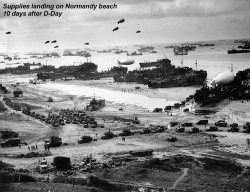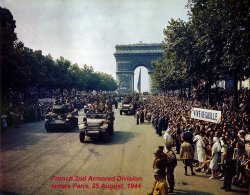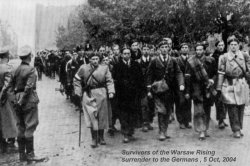LIBERATION OF FRANCE
 On June 6, 1944, at dawn, the greatest amphibious assault ever undertaken was under way. Brave American, British and Canadian soldiers stormed ashore on the Normandy beaches against withering fire from the fortifications on the cliffs above. A tremendous bombardment by heavy navy guns and by Allied planes had considerably reduced the German defense capability, but had not eliminated it completely. Shortly after midnight, paratroopers and infantry
in gliders landed among the hedgerows of the Cotentin peninsula and the Normandy countryside, attempting to block the movement of German reinforcements. By the end of the day a firm beach-head had been established and a total of 165,000 Allied troops had come ashore. This tremendous accomplishment came at the cost of 2499 American dead, and 1915 from other Allied nations, on this day alone. In addition another 6,000 were wounded or were listed as missing.
On June 6, 1944, at dawn, the greatest amphibious assault ever undertaken was under way. Brave American, British and Canadian soldiers stormed ashore on the Normandy beaches against withering fire from the fortifications on the cliffs above. A tremendous bombardment by heavy navy guns and by Allied planes had considerably reduced the German defense capability, but had not eliminated it completely. Shortly after midnight, paratroopers and infantry
in gliders landed among the hedgerows of the Cotentin peninsula and the Normandy countryside, attempting to block the movement of German reinforcements. By the end of the day a firm beach-head had been established and a total of 165,000 Allied troops had come ashore. This tremendous accomplishment came at the cost of 2499 American dead, and 1915 from other Allied nations, on this day alone. In addition another 6,000 were wounded or were listed as missing.
These brave men paved the way for the liberation of western Europe from the Nazi occupiers, and the final defeat of Germany 11 months later.
The Battle of Normandy lasted until the end of August. This was much longer than originally planned, because the German army was able to counter-attack. It was not until July 31 that Operation Cobra succeeded at St. Lo, enabling the Allied forces to break out of the bridgehead and sweep south and east.
On August 22 the US 90th Div attacking from the south and the Polish 1st Armored Division from the north closed the gap near Falaise trapping the remains of the German 7th and 5th Panzer Armies. The Germans lost over 10,000 dead and 50,000 prisoners and huge numbers of tanks, artillery and vehicles. Two days later the Allies crossed the Seine north-west of Paris, advancing rapidly toward Belgium.
Gen. Eisenhower did not wish to waste resources and time on freeing Paris, he was afraid of heavy German resistance and resulting destruction of the beautiful city. Instead he gave orders to press on toward Belgium and the coastal ports, completely by-passing Paris.
 However units of the French Resistance had already taken to the streets of Paris on August 19, after a general strike that started the previous day. Fortunately, the German commander, Mjr. Gen. Dietrich von Choltitz, disobeyed Hitler's orders to destroy the city and the bridges. On the 19th. Raoul Nordling, the Swedish consul-general, negotiated with Choltitz to declare a truce between the German troops in the city and the Resistance. There were a number of skirmishes between Resistance units and German units, but essentially the truce held until the entry of the advance units of LeClerc's French 2nd Armored Division in the evening of August 24. The German general surrendered to Lt. Henri Karcher, representing De Gaulle, the following day. By the end of September, all of France except Alsace-Lorraine, and most of Belgium would be free again. It would take another 7 months of long fighting before all of western Europe was liberated.
However units of the French Resistance had already taken to the streets of Paris on August 19, after a general strike that started the previous day. Fortunately, the German commander, Mjr. Gen. Dietrich von Choltitz, disobeyed Hitler's orders to destroy the city and the bridges. On the 19th. Raoul Nordling, the Swedish consul-general, negotiated with Choltitz to declare a truce between the German troops in the city and the Resistance. There were a number of skirmishes between Resistance units and German units, but essentially the truce held until the entry of the advance units of LeClerc's French 2nd Armored Division in the evening of August 24. The German general surrendered to Lt. Henri Karcher, representing De Gaulle, the following day. By the end of September, all of France except Alsace-Lorraine, and most of Belgium would be free again. It would take another 7 months of long fighting before all of western Europe was liberated.
TRAGEDY IN WARSAW
In eastern Poland, all through July 1944, "Operation Tempest (Burza)" was carried out by units of the Polish underground, Armia Krajowa (AK), against German army units retreating against the Soviet offensive. The city of Vilnius was liberated by AK units and Soviet army on July 14, Lviv was freed after 4 days of fighting on July 27 in a similar joint effort of AK and Soviet forces. In both cases the Polish units were interned by Soviet police forces NKVD, Polish officers were arrested during staff meetings with Soviet officers.
 In Warsaw, since 1942 clandestine units of the AK had been preparing for the eventual day of reckoning, while specialized units carried out attacks against Nazi police units and German transportation hubs. In the last week of July 1944, German army units were in full retreat along the main east-west streets, German families hastily packed up and left the city. The Soviet forces of the Byelorussian front were rapidly approaching the city which sits on a bluff overlooking the river Vistula which is over 200m. (700ft) wide. Only three road bridges and two railroad bridges cross the river, thus occupation of the city would create a valuable bridgehead for further advance westward of the Soviet army. For several days Soviet bombers had been attacking railroad yards and army depots around Warsaw and dropping leaflets exhorting Poles to rise up. On July 30 units of the 2nd. Tank Army of the 1st Byelorussian Front of Marshal Rokossovsky reached Wołomin on the outskirts of Praga, the part of Warsaw east of the river, and gunfire was clearly audible in the city.
In Warsaw, since 1942 clandestine units of the AK had been preparing for the eventual day of reckoning, while specialized units carried out attacks against Nazi police units and German transportation hubs. In the last week of July 1944, German army units were in full retreat along the main east-west streets, German families hastily packed up and left the city. The Soviet forces of the Byelorussian front were rapidly approaching the city which sits on a bluff overlooking the river Vistula which is over 200m. (700ft) wide. Only three road bridges and two railroad bridges cross the river, thus occupation of the city would create a valuable bridgehead for further advance westward of the Soviet army. For several days Soviet bombers had been attacking railroad yards and army depots around Warsaw and dropping leaflets exhorting Poles to rise up. On July 30 units of the 2nd. Tank Army of the 1st Byelorussian Front of Marshal Rokossovsky reached Wołomin on the outskirts of Praga, the part of Warsaw east of the river, and gunfire was clearly audible in the city.
In spite of the treatment that AK units had received from the Soviets in eastern Poland, the underground government and General Bor-Komorowski, the commander of AK, agreed to go ahead with the planned Uprising, designating W-hour at 17:00 of August 1. The resistance units had been in a state of mobilization for a week. Although very poorly equipped and completely lacking heavy weapons, the 20,000 men and women of the underground army took the Germans by surprise and after two days had a substantial part of the city, except for German fortified strong-points, under their control. Effectively they severed all lines of communication to the German units fighting the Soviets on the eastern outskirts of the city. The civilian population enthusiastically upported the AK, erecting barricades across the streets, organizing kitchens, digging wells, carrying food supplies from captured German warehouses. Thousands joined the ranks of AK.
Joseph Stalin, however, had no intention to allow a Polish force not under his control to take over the capital city. All Soviet planes disappeared from the skies, not to be seen again for six weeks. All units were ordered to pull back. The Second Tank Army was already engaged in a battle with four German armored divisions in the area Wołomin-Radzymin on August 1. Deprived of support it suffered heavy losses, and fell back some 20km (12 miles) during the next 5 days.
The Germans could now divert their forces to the destruction of the insurgents. They quickly retook the western part of the city slaughtering civilians and captured partisans without mercy. Heavy tanks drove wedges separating the A.K. into several groups and regained two of the three road bridges and one railway bridge.
With no Soviet air intervention, German bombers methodically destroyed the city, block by block. Allied planes manned by British, Polish and South African crews, flew from bases in southern Italy to bring desperately needed supplies. But the Soviets denied them landing rights on airfields less than 100 miles from Warsaw. Churchill was furious and demanded that President Roosevelt join him in personal protests to Stalin. But Roosevelt hoping for Soviet support in the future battle against the Japan islands, refused. It was not until September 18 that, as a result of a public outcry in the U.S., that a flight of 107 B-17 flew over Warsaw and landed at Soviet air-base. However, it was too late, by this time the area of the city still in Polish hands had been cut to three small enclaves and most of the supplies dropped into German hands.
 Except for the undermanned 73rd. Infantry Division, by the third week of August, German forces had withdrawn from the east of Warsaw, but the Soviet army made no attempt to move in. Finally, on September 13 the Germans withdrew completely, blowing the bridges, and the Soviet army occupied the east bank of the Vistula, only a few hundred meters from the struggling Poles. Three battalions of the 1st Polish Army of General Berling made several attempts to cross the river but were given no air or artillery support by other units of the Soviet army. 900 men made it across and linked up with the embattled AK in the river-side district of Czerniaków, but all their boats were destroyed by German fire from the heights above. General Berling was dismissed by Marshal Rokossowsky.
Except for the undermanned 73rd. Infantry Division, by the third week of August, German forces had withdrawn from the east of Warsaw, but the Soviet army made no attempt to move in. Finally, on September 13 the Germans withdrew completely, blowing the bridges, and the Soviet army occupied the east bank of the Vistula, only a few hundred meters from the struggling Poles. Three battalions of the 1st Polish Army of General Berling made several attempts to cross the river but were given no air or artillery support by other units of the Soviet army. 900 men made it across and linked up with the embattled AK in the river-side district of Czerniaków, but all their boats were destroyed by German fire from the heights above. General Berling was dismissed by Marshal Rokossowsky.
The German army, faced with continuing losses, changed its policy toward the AK On September 7, Mjr.Gen Rohr (commander of one of the German two battle-groups) proposed negotiations. Gen. Bor-Komorowski faced with catastrophic losss, starvation and shortage of ammunition, accepted. The German general promised recognition of the A.K. insurgents as regular forces, to be treated in accordance with the Geneva Convention. During periods of cease-fire the following three days, over 20,000 civilians left the city. Then renewed Soviet activity brought hope of help and Bor-Komorowski broke off the negotiations. The help did not materialize and on 28 September negotiations were renewed. Capitulation came October 2, after 63 days of fighting in unbelievable conditions.
About 15,000 of the surviving insurgents were taken to P.O.W. camps, the entire surviving civilian population was evacuated to transit camps west of Warsaw. All younger people were taken to labor camps in Germany, the wounded and elderly and children were allowed to resettle among the civilian population of occupied Poland. The total number killed during the Rising were estimated at: 15,000 insurgents, 150,000 civilians, 15,000 German army.
Under direct orders of Hitler, German engineer units systematically destroyed virtually all buildings still standing in the deserted city.
REFERENCES
- About D-Day and Battle of Normandy,
- Liberation of Paris,
- Detailed timeline of Warsaw Rising
- Photographs and films of Warsaw Rising,
- Detailed eye-witness accounts,
- Documents re refusal of Soviets to assist Poles,







